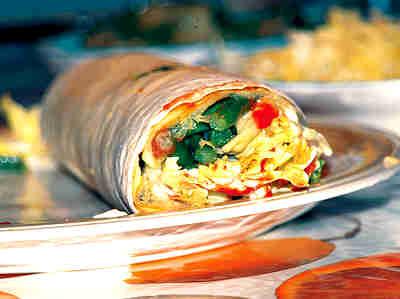Customer ordering patterns were unchanged after a Mexican-style fast food chain posted the calorie counts of its offerings. Karen Hopkin reports
墨西哥风格的快餐连锁店公布其饮食中的卡路里后,就餐者的点餐风格依然未变。Karen 凯伦·霍普金报道
We Americans love our fast food. And a new study shows that a little thing like a nutrition label is not gonna stop us when we want a breakfast burrito.
我们美国人喜欢快餐。一项新研究表明营养成分标签并不会扼杀人们想吃玉米煎饼的念头。
 In January 2009 King County, Washington imposed mandatory menu labeling on all restaurant chains in the region, which includes Seattle and its surrounds. Restaurants were asked to disclose nutrition information, including a calorie count, about every item on the menu.
In January 2009 King County, Washington imposed mandatory menu labeling on all restaurant chains in the region, which includes Seattle and its surrounds. Restaurants were asked to disclose nutrition information, including a calorie count, about every item on the menu.
2009年1月,华盛顿在国王郡要求所有在西雅图及其周边地区的餐馆连锁店都使用强制性菜单,要求餐馆公开菜单上所有食品的营养信息,其中包括卡路里计数。
Then, over the next year, researchers in conjunction with local public health officials monitored food purchases at the Taco Time chain of restaurants. And they found that nothing changed. The total number of sales and the average calories per order were the same, regardless of whether the restaurant labeled its menu. The study appears in the American Journal of Preventive Medicine.
而且,在第二年,研究人员与当地公共健康行政人员检测了从Taco Time连锁店 买到的食物。他们发现并没有什么改变:出售的总数以及每份订餐的平均卡路里还是老样子,人们根本不考虑餐馆是否在菜单上标示出营养成分。这项研究发表于《美国预防医学期刊》。
Now, it could be that Taco Time customers were already wise to the relative nutritiousness of their meals, because the restaurant was highlighting its healthier options with a little logo before the law took effect.
现在,Taco Time的顾客们对于饮食中相关的营养成分很了解了,因为在法律实施前,餐馆为了突出自己提供的更健康的食物,已经在使用小标示了。
So maybe all we need is a happy, "healthy icon" to keep us from overdoing it. Because pointing out that a large order of cheddar fries has 700 calories was not food for thought.
因此,我们只是需要一个快乐、“健康的图标”,而不是矫枉过正。因为大份切达干酪炸薯条含有700卡路里,并不在人们点餐的考虑范围内。
 In January 2009 King County, Washington imposed mandatory menu labeling on all restaurant chains in the region, which includes Seattle and its surrounds. Restaurants were asked to disclose nutrition information, including a calorie count, about every item on the menu.
In January 2009 King County, Washington imposed mandatory menu labeling on all restaurant chains in the region, which includes Seattle and its surrounds. Restaurants were asked to disclose nutrition information, including a calorie count, about every item on the menu.











